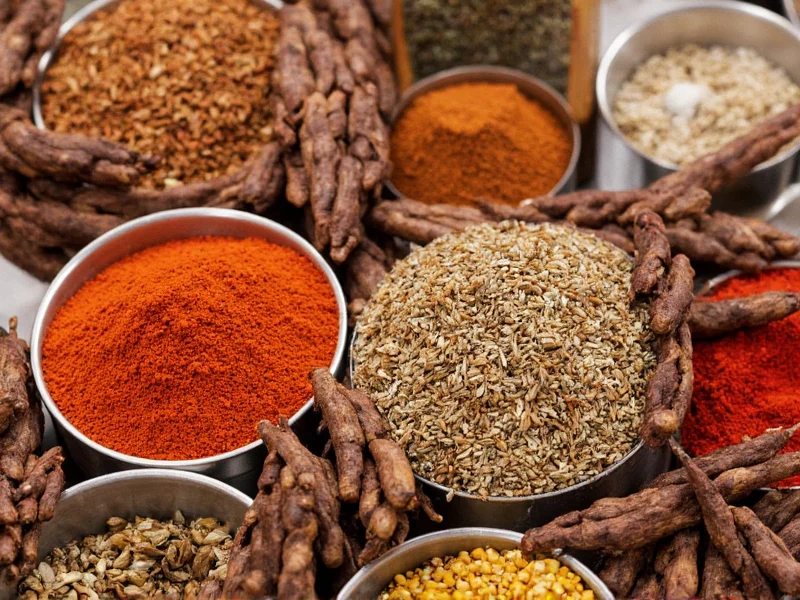Understanding spice shelf life helps prevent unnecessary food waste while ensuring your dishes deliver optimal flavor. While spices don't become unsafe to consume like perishable foods, their quality degrades significantly over time, affecting your cooking results. The actual longevity depends on multiple factors including spice type, storage conditions, and initial quality.
Factors Affecting Spice Longevity
Spice shelf life isn't determined by a single expiration date but by several critical factors. Proper understanding of these elements helps maximize your spice investment and culinary results.
Spice Form: Ground vs. Whole
Whole spices maintain freshness significantly longer than ground varieties. When spices remain whole, their essential oils stay protected within the seed, pod, or bark. Grinding exposes more surface area to air and light, accelerating flavor and aroma loss. This explains why how long do ground spices last is typically shorter than whole spice varieties.
Storage Conditions Matter Most
The environment where you keep your spices dramatically impacts their shelf life. Three enemies of spice freshness include:
- Light - Causes fading and chemical breakdown
- Heat - Accelerates essential oil evaporation
- Moisture - Promotes clumping and potential mold
Spices stored in clear containers on a sunny kitchen counter may lose potency in months, while those kept in dark, airtight containers in a cool cupboard can maintain quality for years.
Spice Shelf Life Reference Guide
While individual results vary based on storage, this reference provides general expectations for properly stored spices:
| Spice Category | Optimal Shelf Life | Signs of Degradation |
|---|---|---|
| Ground Spices (cinnamon, cumin, paprika) | 2-3 years | Faded color, weak aroma, diminished flavor impact |
| Whole Spices (peppercorns, cinnamon sticks, cloves) | 3-4 years | Loss of strong scent when crushed, diminished flavor when ground |
| Dried Herbs (basil, oregano, thyme) | 1-3 years | Brittle texture, faded green color, hay-like smell |
| Spice Blends (curry powder, chili powder) | 1-2 years | Noticeable flavor imbalance, weak overall impact |
| Leafy Herbs (bay leaves, mint, sage) | 1-2 years | Crumbly texture, loss of distinctive aroma |
How to Determine If Your Spices Are Still Good
Instead of relying solely on time-based estimates, use these practical methods to assess your spices' current condition:
The Scent Test
Fresh spices should release a strong, distinctive aroma when opened. Rub a small amount between your fingers to release essential oils, then smell. If you need to inhale deeply to detect any scent, or if the aroma seems weak or musty, the spice has likely lost significant potency. This is the most reliable method for determining how to tell if spices are expired without wasting product.
The Color Check
Bright, vibrant colors indicate freshness. Ground spices like paprika and turmeric should maintain intense hues. If your red spices have turned brick-colored or yellow spices have faded to pale yellow, they've likely lost much of their flavor compounds. Properly stored whole spices show less visible color change but still degrade internally.
The Taste Test
For definitive assessment, taste a tiny amount. Fresh spices deliver immediate, complex flavor. Degraded spices taste flat, one-dimensional, or barely noticeable. Remember that do spices go bad isn't about safety but about whether they'll contribute meaningfully to your dish. If you need to use double the recommended amount to achieve flavor, it's time to replace your spice.
Maximizing Spice Freshness: Storage Best Practices
Implement these evidence-based storage techniques to extend your spices' useful life:
Choose the Right Containers
Transfer spices from flimsy store packaging to airtight containers made of dark glass or opaque materials. If using clear containers, store them inside a closed cupboard away from light. The best way to store spices involves minimizing exposure to all degradation factors simultaneously.
Control Temperature and Humidity
Store spices in a cool, dry place away from your stove, oven, or dishwasher. Ideal storage temperature ranges between 50-70°F (10-21°C). Avoid refrigerator storage for most spices as temperature fluctuations cause condensation, introducing moisture that accelerates degradation.
Buy Smaller Quantities
Purchase spices in quantities you'll use within 6-12 months for optimal freshness. Specialty stores and bulk sections allow buying just what you need. This approach addresses the practical concern of when to replace spices by ensuring you're always working with reasonably fresh product.
Label with Purchase Dates
Mark containers with purchase or opening dates using waterproof labels. This simple practice helps track shelf life of whole spices and other varieties without relying on memory. Rotate stock using the "first in, first out" principle to prevent older spices from getting buried and forgotten.
Special Considerations for Specific Spices
Certain spices require special attention due to their unique properties:
Saffron: The Delicate Exception
This expensive spice maintains quality for 2-3 years when stored properly in its original airtight container in a cool, dark place. Exposure to light particularly damages saffron's delicate compounds. Store it separately from stronger spices as it readily absorbs surrounding odors.
Spice Blends: Shorter Lifespan
Commercial blends often contain ingredients with varying shelf lives. The weakest component determines the blend's overall longevity. Homemade blends typically last 3-6 months. Understanding how long can you keep dried herbs in blends helps manage expectations for flavor consistency.
Vanilla: Liquid Longevity
While not a dry spice, pure vanilla extract maintains quality for 2-4 years when stored properly. The alcohol content preserves it, but light and heat still degrade flavor compounds over time. Avoid storing near heat sources or in clear bottles on open shelves.











 浙公网安备
33010002000092号
浙公网安备
33010002000092号 浙B2-20120091-4
浙B2-20120091-4